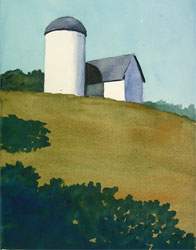

MATERIALS LIST
Hover Or Click
A Color For Information
Burnt Sienna
A sedimentary color; sediments quickly offering a mottled or shimmery look to the final (wash)
+ close +Viridian
A sedimentary color; sediments quickly offering a mottled or shimmery look to the final (wash)
+ close +Pthalocyanine Blue
A "warm" (greenish) blue.
A non sedimentary color settles out smoothly yielding a uniform finish (wash)
+ close +Pyrrol Red
A "warm" (orangish) red.
A non sedimentary color settles out smoothly yielding a uniform finish (wash)
+ close +Arylide Yellow FGL
A "warm" (orangish) yellow.
A non sedimentary color settles out smoothly yielding a uniform finish (wash)
There is not an industry standard name for this color. I am offering DaVincis Brand name.
+ close +Yellow Ocher
A sedimentary color.
sediments quickly offering a mottled or shimmery look to the final (wash)
+ close +Cerulean Blue
A sedimentary color.
Sediments quickly offering a mottled or shimmery look to the final (wash)
+ close +Ultramarine Blue
A cool (purplish) blue.
A non sedimentary color settles out smoothly, theoretically yielding a uniform final (wash).
Actually Ultramarine Blue "flocculates" (gathers in clumps) so we only get a fairly smooth (wash)
Sadly, it's the only purplish blue thats light-fast and available to artists.
+ close +Alizarin Crimson
( Quinacridone )
A cool (purplish) red.
A non sedimentary color settles out smoothly yielding a uniform finish (wash)
n fact, Alizarine Crimson (a very early man made pigment) lost favor when it was found non light-fast.
Today we replace it it with a better version of the same color called Quinacdridone Red.
Nevertheless, manufacturers still call it Alizerine Crimson.
+ close +A cool (greenish) yellow
A non sedimentary color settles out smoothly yielding a uniform finish (wash)
There is not an industry standard name for this color. I am offering the DaVincis Brand name.
+ close + Whatever
your medium, oil paints, (oils). acrylic, pastel, and especially
watercolor, if you are a landscape painter. this lesson is for you.
Whatever
your medium, oil paints, (oils). acrylic, pastel, and especially
watercolor, if you are a landscape painter. this lesson is for you.
This lesson is about using shadows effectively in landscape painting.
The subject of this watercolor is a barn and silo, and not much else. The barn is white, Pennsylvania Dutch style white, so that we may better see the pure color effects without the confusion added by extraneous hues. As always we will mix some of our colors on the paper, and some on the palette.
In this art lesson we cover:
- Shadows on flat surfaces.
- Shadows on rounded objects
- Shadowing of downward facing surfaces.
- Shadows cast by overhanging horizontal objects.
- Cast shadows.
- Foreground shadows.
- Shadows as design elements used as objects in the painting.
- We cover a lot of abstract concepts such as using foreground shadows to create sanctuaries. The relative darkness, "values" of each of the different kinds of shadows is extremely important to make a painting realistically effective.
- Our most significant painterly concept is that landscape shadows have very specific colors; that the colors are influenced by surrounding objects and by the sky above. We learn that we can use these colors to effect the human psyche. That good feelings, feeling of well being, can be engendered simply by the colors used in shadows.
In this art lesson I try to show you how much we think we know, and that much of our knowledge is false. The implications here are huge, ranging from jury selection to believing our own eyes.
The lesson runs; 34 Minutes, the first ten minutes is on theory, and the rest we will spend watercolor painting . We will use just a few different paint colors, 140 pound cold presses watercolor paper and one inch and half inch flat watercolor brushes.
If you are not fascinated by this lessons, contact me for a full refund.
If you are fascinated by this lesson, write and let me know what you got from it.
Watercolor Painting Tutorials Watercolor Materials

A Wet In Wet Watercolor Painting Lesson.

How To Create Depth In A Painting.

Painting A Basket - A Lesson Lifting Watercolor Paint - Part 1.

Filling The Basket - A Lesson In Painting Objects Part 2.

Watercolor Lesson - Monoprinting - Texturing With Plastic Wrap.

Landscape Shadows. A Demonstration

Color For Beginners - How to mix all the colors.

Color schemes - How to plan the colors of a painting.

How to paint emotions using warm and co

Abstract Art - A discussion.